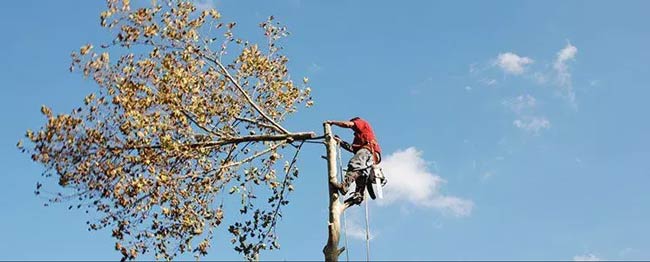Tree trimming is a part of a regular maintenance plan for all trees in the urban landscape. Regular trimming helps give the tree a new lease on life and improves the curb appeal of your home.
The best time of year to trim your trees is during late winter. This is because they are dormant and handle the shock of a heavy trim better. As trees switch on in spring, they acclimate slowly and respond better.
You can do light pruning year-round such as removing dead branches or other remedial pruning.
Does it differ for evergreens or fruit trees? Let’s find out the best time of the year for different trees in this article.

What we cover
ToggleTimes of year to trim different tree types
Deciduous trees
Always prune deciduous trees in late winter or early spring before the leaves start to grow back. A large trim is a bit of a shot to the tree, so doing so while the tree is dormant is going to be less of a shock as the tree “switches on” slowly over the coming month in early spring.
Evergreens
When it comes to evergreen trees including spruce and fir, you can trim on the same time frame as their deciduous counterparts. These trees have side buds, so cut branches just above them. Remove unwanted branches from the bottom of the trees as they are about to die.
Fruit trees
Fruit trees should always be pruned from late February to early April in the northern hemisphere and between early spring break in the southern hemisphere. If you trim fruit trees in fall or early winter, they will bleed heavily and damage the growth.
Best time for maples
Since maples are deciduous trees, they should be pruned in late winter or early spring. It tends to bleed on trimming in late winter, but that doesn’t harm its sap or growth.
Best time to trim oak trees
It goes the same for oak trees. Prune them in winter to minimize any harm. You should never remove more than 10 to 15 percent of the branches as it can stress out the tree.
Can you still trim trees in summer?
The general rule of thumb is you should always trim large branches in winter when the tree is dormant. Also, since there are no leaves on the tree, you tend to make less mess, so you will normally pay less if you decide to get a professional in to do the job. You can, however, carry out small pruning sessions in the summer. I suggest no more than 10% of the tree’s foliage.
If you plan your trimming schedule accordingly, there should never be a reason to trim in summer. If an emergency does arise though, such as a broken branch, it should be fine to tidy it up in summer. If you trim at the end of summer, you will do minimum damage to the branches.
Dead branches can be removed year-round.
Should you prune trees in late winter or early spring?
The best time of year to prune your trees is late winter is definitely the best time to prune. You are a little late and the trees have started to bud early, you could have a negative impact on the tree if you are planning a large prune.
Although we are only talking about a few weeks’ difference, the healing time and potential of the tree are going to be the same, but it’s the shot to the tree you want to avoid.
Here are a few more reasons to prune in winter:
- The ground becomes hard, so it is easy for you to climb up a ladder to trim the branches.
- Since the tree is dormant, it is easy to manage diseases
- It promotes the health of trees as you cut out old and dying branches
- You free up resources for the tree so it can focus on fruiting and flowering rather than managing the current number of branches.
- It is more convenient to clean the cut branches because no leaves are scattered on the ground.
What about ornamental trees?
There are a few factors that decide the pruning time for ornamental trees:
- The tree’s tendency to bleed
- Its flowering, fruiting, or growth habits
- Pruning should boost the tree’s growth and not negatively affect it
You can prune ornamental trees throughout the year because the flowering season is different for different trees.
One simple rule to remember is that pruning should take place immediately after the flowering season.
For more ornamental trees in the northern hemisphere, pruning should be done in June, while for those in the southern hemisphere, December is the right month.





When is the cheapest time of year to have trees trimmed?
Most tree services are small businesses that are busy in the summer and quiet in the winter. Although you can see from the above article that the best time of year to prune is winter, most ignore that and do most of their pruning and removal in summer.
Because people are out and about in their yards, gardens tend to get a lot more attention.
Because of the high demand in summer, winter is ideal to get your trees trimmed because you will save yourself 20 – 30% minimum.
Towards the end of winter, most tree services are fighting tooth and nail to get any work going around, so in most cases, the cost of tree trimming is reduced substantially.
Make sure you get your price or quote to trim trees in winter, as that’s when the savings are had.
Pruning tips
- Only cut branches that are less than five centimeters in diameter. Only cut a branch between five to 10 centimeters if it is damaged. Never cut branches that are bigger than 10 centimeters in diameter unless you have a good reason, for example, if it is diseased.
- Minimize trimming activity in the summer to prevent the branches from falling off and damaging property structures or hurting your children. Only cut the necessary branches.
- Always balance both sides of a tree. Prune branches that cross other branches but keep those that form a lateral structure. I plan to trim the crown of the tree, don’t prune more than 1/4th of the total size. In case you want to trim out more, do it over the years and not just at once.
- Have a clear objective before you start such as more light in your home, or reduce overall tree size. When you know what your goal is, it is easier to get the result you are after rather than just randomly removing branches.










